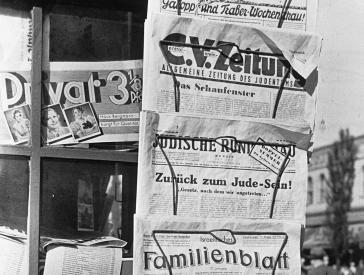"bios [torah]": Robot Writes Torah Scrolls
Press Information
Press Release, Thu 10 Jul 2014
Starting on 10 July 2014, for the very first time an industrial robot specially programmed for Hebrew script will write a Torah. The installation "bios [torah]" (10 July 2014 to 11 January 2015) at the Jewish Museum Berlin forms a counterpoint to the Torah scribe at work in the exhibition "The Creation of the World. Illustrated Manuscripts from the Braginsky Collection" (3 April to 4 August 2014), which presents the world’s largest private collection of Hebrew manuscripts.
In the installation "bios [torah]" by the artist group robotlab, a human-sized robot takes on the role of a sofer, a Torah scribe whose task is to copy Torah scrolls, the verses for phylacteries (tefillin) or doorpost boxes (mezuzot), and other religious texts. "Writing a Torah is a sacred act that is performed by specially trained scribes. You might say that in his work, the Torah scribe creates the world again," explains Cilly Kugelmann, Program Director of the Jewish Museum Berlin. The Torah - the word means instruction or teaching - comprises the five books of Moses, and begins with the sentence the scribe must write first of all: "In the beginning, God created the heaven and the earth."
- Kontakt
-
Press office
T +49 (0)30 259 93 419
presse@jmberlin.de
- Address
Jewish Museum Berlin Foundation
Lindenstraße 9–14
10969 Berlin
304,805 letters in three months
The robot picks up the copying labor of the sofer. The writing arm with its calligraphic nib and ink will work for ten hours every day (during opening hours) at a human writing speed. By the end, it will silently and elegantly have written 304,805 Hebrew letters in the right-to-left direction of Hebrew script. The robot will need only three months to fill the 80 meters roll of paper, whereas it generally takes a specially qualified scribe a year or more to carry out this sacred work. Two Torah scrolls will be created in this way by January 2015, the first of which will be added to the Jewish Museum Berlin’s collection.
However, the robot-written Torah cannot be used in the synagogue. It does not satisfy the requirements imposed upon a Torah scribe and is therewith not kosher. The sofer must write the text onto parchment obtained from kosher animals and use a quill pen with special ink. When the robot writes, it is devoid of intention, knows no blessings, and does not have the inner devotion of the trained sofer.
As part of the exhibition "The Creation of the World. Illustrated Manuscripts from the Braginsky Collection," the installation "bios [torah]" by the artist group robotlab offers a modern contrast to the traditional work of the Torah scribe, which Rabbi Reuven Yaacobov has been demonstrating in the exhibition Sundays to Thursdays since April 4.
From bios [bible] to bios [torah]
The artist group robotlab explores the relationship between mankind and machine. Using industrial robots, the artists deliberately generate situations in which a machine carries out cultural activities otherwise reserved for human beings alone.
The installation title refers to an elementary component of computer technology, the Basic Input/Output System (BIOS). The BIOS is the system on which all a computer’s other programs build. It is fundamental to the development of machines - just as scripture is fundamental to the cultural history of human beings.
Previously, "bios [bible]" wrote Luther’s Bible in three languages, German, Spanish, and Portuguese. The typographies it used were "Alte Schwabacher" (for German) and "Rotunda" (for Spanish and Portuguese). The installation was shown for the first time in 2007, at the ZKM Center for Art and Media in Karlsruhe. Numerous exhibitions followed, and in 2012, in front of Trier Cathedral in western Germany, the "Trier Robot Bible" was made, a copy of Lutheran scripture like those the robot had already created several times. Once bound as a book, this bible filled six thick volumes and weighed in at 57 kilograms. Today it is held in the Trier Cathedral Archives.
Artist Group: robotlab / Matthias Gommel, Martina Haitz, Jan Zappe
Robot Installation: "bios [torah]" (2007/14)
Work on Hebrew Calligraphy and Typesetting: Sahar Aharoni, Karlsruhe
With the kind support of: ZKM Karlsruhe, KUKA Augsburg, LAMY Heidelberg, PAPIER UNION Karlsruhe, CORDIER Papier Bad Durkheim, WINTOPO Biggleswade/UK




